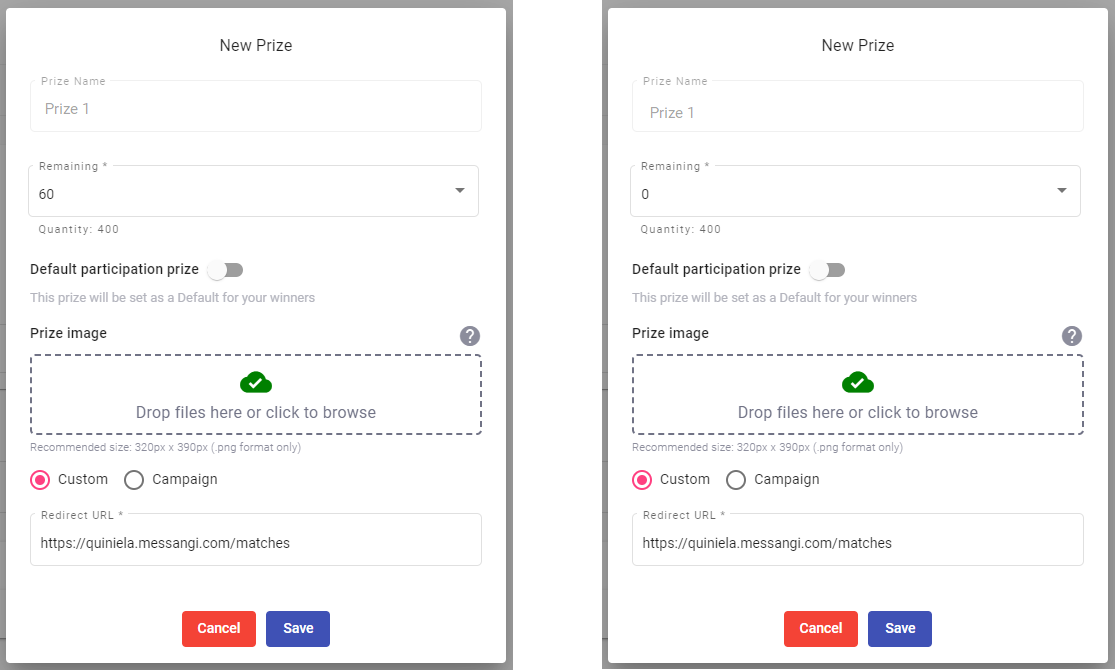Prize Configuration
Campaigns that hand out prizes require additional input to create a method for their delivery: number of prizes to be won, different prize types, frequency of awards, informing the user if they won or lost, etc.
Prize Configuration is where you set how the platform will give prizes away, and it is part of the setup of the following campaigns:
- Raffle Giveaway
- Trivia
- Web Trivia
Prize Configuration is enabled by default, and if the campaign does not have prizes associated with it, the toggle switch should be disabled.

To add prizes to a campaign, two areas need to be configured:
- Prize Logic, where you select how prizes will be given away, and
- Prizes, a pop-up form where the details of a prize are entered.
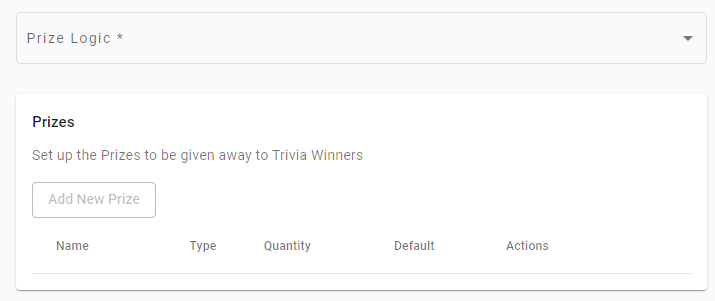
Prize Logic
Depending on the campaign type, it will show either three or four options:
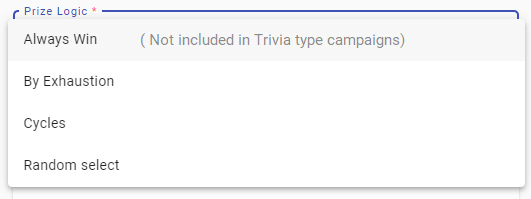
- Always Win - Always Win is intended to be used when the campaign is to assign prizes to all participants. The proper dimensioning of the prizes is key, as this campaign will not provide feedback to participants if all prizes have been given away. Always Win logic does not apply to Trivia-type campaigns.
- By Exhaustion (Limited Quantities) - Similar to Always Win, By Exhaustion incorporates a feedback notification to the participants once there are no more prizes to be given away in the campaign.
- Cycles - The Cycles Prize Logic is a random prize allocation method based on several participations that can be conditioned with a time element. It is a flexible and powerful prize allocation scheme that has multiple configuration variants that must be understood thoroughly to leverage its full potential.
- Random Select - In this scheme, you define how many participations need to take place before a prize is awarded, establishing the frequency of awards as a function of the number of participations.
Always Win & By Exhaustion
For these two logics, the platform behavior is conditioned on the number of prizes and the size of the targeted audience. But as far as awarding the prizes, the platform behavior will be identical with one significant difference, that can be inferred from the logic's name:
-
For Always Win, the idea is to always present the campaign participant with a prize. In a sense, this means that the definition of prizes and the audience size is of relevance in order to award a prize for every participation.
-
For the case of By Exhaustion, the idea is to present a prize to the campaign participant while supplies last, so the relationship between prizes and the audience size takes on a different meaning.
ABOUT PARTICIPATION FEEDBACKThe Always Win logic will notify the participant of the prize that is being awarded, but it will not offer any feedback to participants once there are no more prizes left.
The By Exhaustion logic will likewise notify the participant of the prize that is being awarded, and it will offer feedback to participants once all the prizes are given away, that there are no more prizes left.
Audience size
Though this scenario may seem counter to an Always Win logic (not so for a By Exhaustion logic), an undefined audience size can be used as long as the prizes are aligned adequately with the campaign. An example would be through the use of a Subscription form-generated QR code, made available to the general public through mass communication channels -print media, posters, and TV consumer product packaging. For this case, the Default participation prize could play an important role in a campaign using an Always Win logic, allowing to reach vast audiences without having to define a fixed number of prizes. A coupon discount would be an example of this scenario.
Given that a By Exhaustion logic is less sensitive to the quantity of prizes since it is a limited quantities campaign with prizes awarded on first-come, first-serve basis, it will generally have associated to it a "sense of urgency" component nudging the audience to take part in the campaign earlier than later so the number of participants is only limited by the campaign's goals.
Cycles
The Cycles' prize logic, unlike Always Win and By Exhaustion, which operate on a continuous, uninterrupted timeline, is a random prize allocation method based on several participations that can be conditioned with a time element. It is a flexible and powerful prize allocation scheme that has multiple configuration variants that must be understood thoroughly to leverage its full potential.

When you select the Cycles option, three different settings will immediately appear:
-
Cycle Count: It defines the number of participations under which a prize can be awarded. Its default value is 100. Using the default value as a reference, as the first participant arrives, the platform will initiate the participation count and randomly select anywhere in the count who is to be awarded a prize on its count up to the 100th participation. Once it reaches the Cycle Count value, it will initiate a new cycle or it will suspend the count, given the conditions described in Reset Count Daily (see below). This is an important parameter in the configuration of a campaign because it establishes the frequency at which prizes will be awarded. A graphical representation of a sequence of cycles is shown below.

-
Reset Count daily: It allows you to control the allocation of prizes within a day using the Cycle Count as input. Using the default Cycle Count value as a reference, Reset Count Daily restricts the allocation of prizes to the first 100 participants, in other words, to the Cycle Count value. When the campaign starts, the platform will begin counting participations and randomly assign prizes as participations arrive.
There are two scenarios.
-
If the number of participations reaches the Cycle Count value of 100 before the day ends, any participation after the 100th participation, within this same day, will not be eligible for an award. Once the next day begins, a new cycle count will begin with the first participation it receives. The image below is a graphical representation of the behavior.
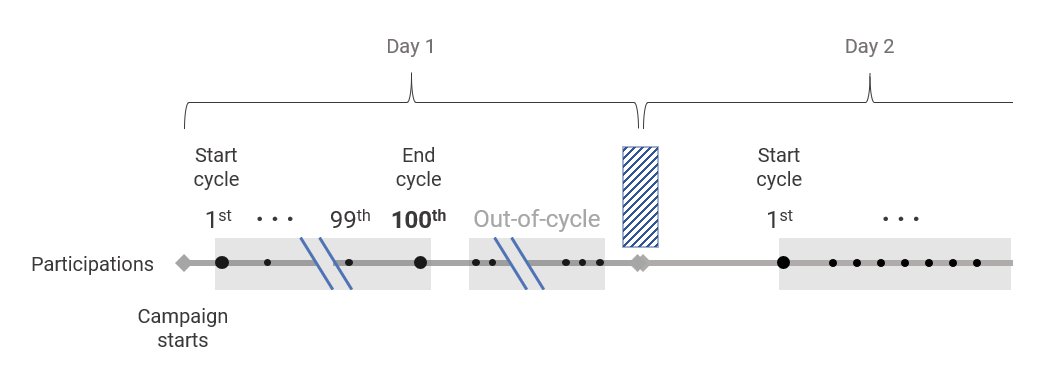
-
If the number of participations does not reach the Cycle Count value of 100 by the end of the day in which the cycle began, the count will spill over to the next day advancing the participation count until it reaches the 100th participation the next day, and possibly awarding prizes in that portion of the cycle. Immediately after completing the cycle that started on the previous day, the platform will initiate a new cycle as soon as it receives the next campaign participation.
-
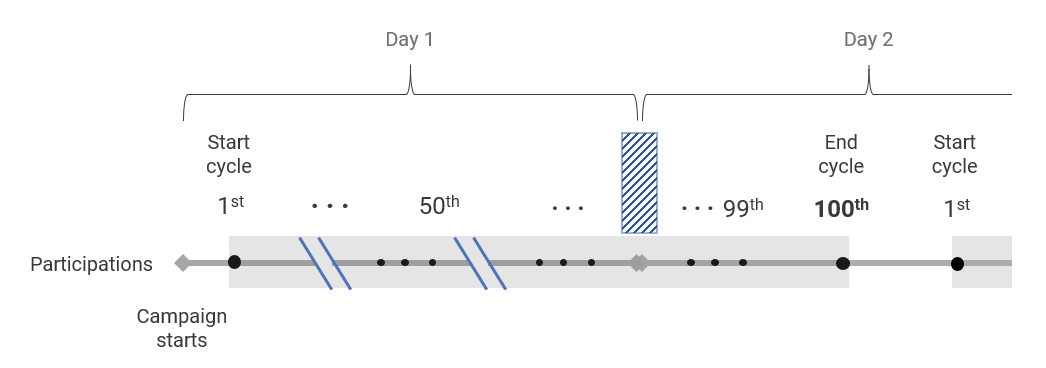
- The One Prize per Participant check box allows you to restrict the award of prizes to only one prize per participant over the entire campaign.
Defining the prizes for a Cycles logic is different from what we have seen in the other prize logics. But you still have the option to define 1, 2, 3, or as many prizes as needed to accomplish the campaign’s goal. As before, you start by selecting Add New Prize. The popup form will have some familiar elements and an additional element that controls how many are going to be given away within a cycle, called the Drops/Cycle (Drops per Cycle).
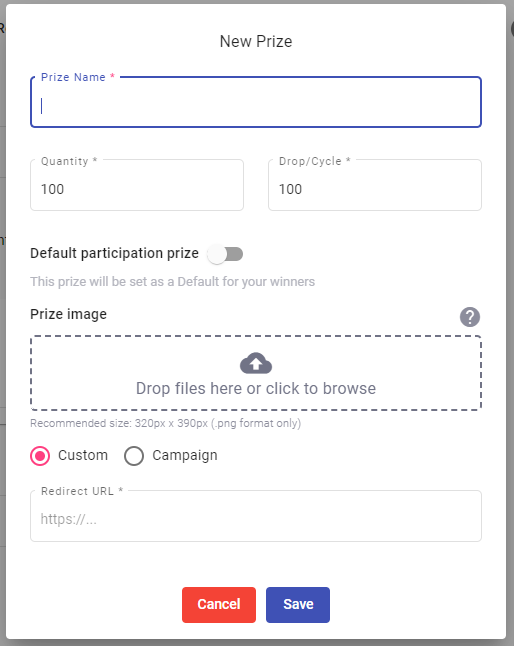
The default value is set to 100. An example of how it works would be, say that you have 3 free dinners and 6 desserts to give away as prizes. You would enter under Quantity, in the free dinner form 3, and the free dessert form 5. The sum of the two, 8, would be the total number of prizes that would be awarded through the campaign. If you set in the free dinner form the Drops/Cycle to 1, and in the free dessert form the Drop/Cycles to 2, in each cycle the platform will award 1 free dinner and 2 free desserts in the campaign. This would take place for 3 consecutive cycles. So if the Cycle Count was set to 100, it would require somewhere between 200 and 300 participations to deliver all the prizes. A recreation of what the first two cycles could look like is shown in the figure below.

Let us show you how all the elements interact together in a hypothetical campaign and several approaches that could be used to create it.
In this campaign, you would give away 9 prizes, 3 smartphones and 6 memory sticks in a three-day trade show.
First approach
The campaign Prize configuration would be set up as follows,
- Cycle count: 300
- The smartphone prize would be set up with
- Quantity 3, and
- Drops/Cycle 3
- The memory sticks would be set up with
- Quantity 6, and
- Drops/Cycle 6
The award of prizes could be such as it shown in the figure below.
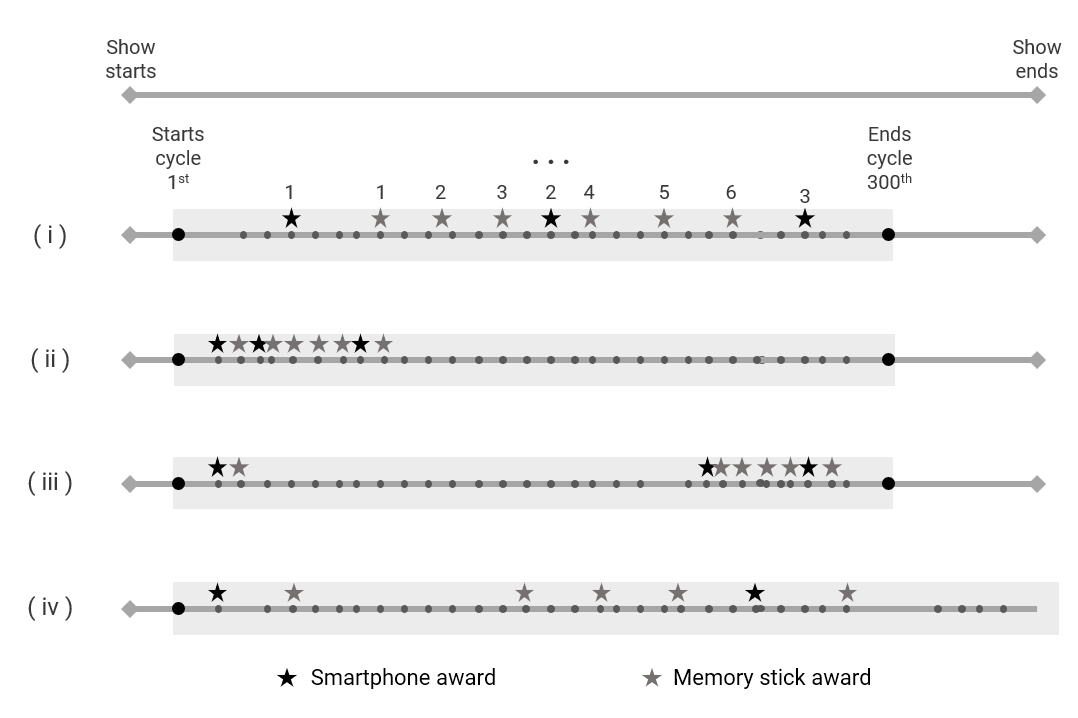
From the figure, you see four different possible outcomes from an infinite number of possibilities, where case (i) shows a somewhat even distribution of awards, case (ii) the awards being piled-up at the early participations, case (iii) with two awards at the early participations and the rest at the later ones, and case (iv) where the number of participations was not sufficient to give away all the prizes. In other words, the awards can occur at any participation in a single cycle. This could very well suit the purpose for some campaigns.
Second approach
The campaign Prize configuration could also have been set up as follows,
- Cycle count: 100
- The smartphone prize would be set up with
- Quantity 3, and
- Drops/Cycle 1
- The memory sticks would be set up with
- Quantity 6, and
- Drops/Cycle 2
The award of prizes could be as shown in the figure below.
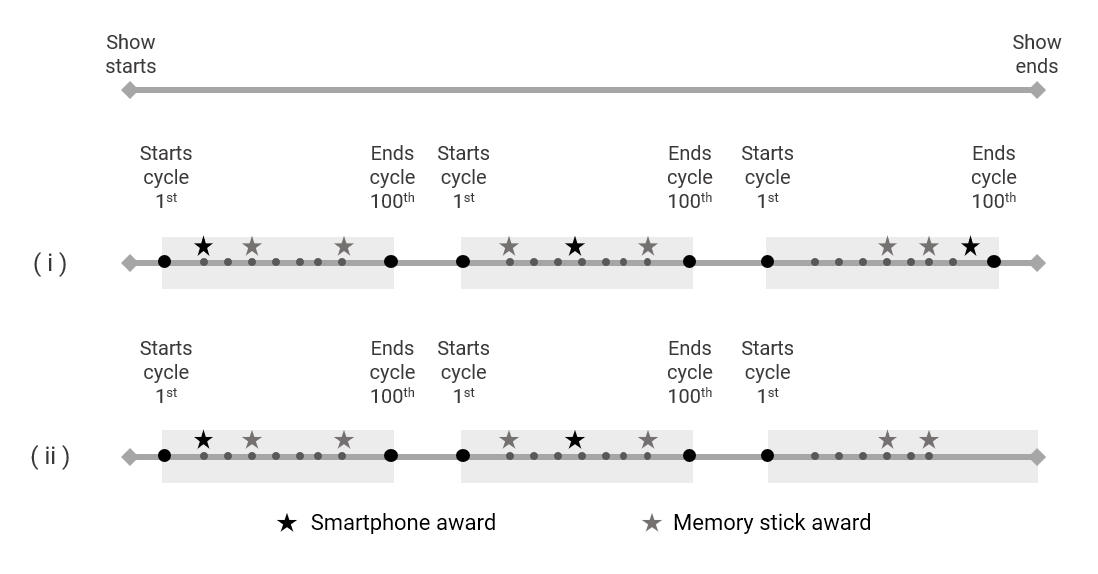
From the figure, you see two different possible outcomes, again, from an infinite number of possibilities, but the allocation of prizes has now been restricted in number on a per-cycle basis. Case (i) shows random awards of the three prizes in each cycle, with one prize being a smartphone (Drops/Cycle= 1), and the other two, memory sticks (Drops/Cycle= 2). Case (ii) shows the same outcome for the first two cycles, and for the third cycle, it only shows two prizes being awarded, as the participants did not complete the cycle, and one prize was not awarded.
Notice that in the two approaches that we described, the three days of the campaign did not come into play and were not addressed.
Third approach
In this case, we will introduce the three days that the campaign is going to run for, using the setup in the second approach. So we have,
- Cycle count: 100
- The smartphone prize would be set up with
- Quantity 3, and
- Drops/Cycle 1
- The memory sticks would be set up with
- Quantity 6, and
- Drops/Cycle 2
The award of prizes could be as shown in the figure below.
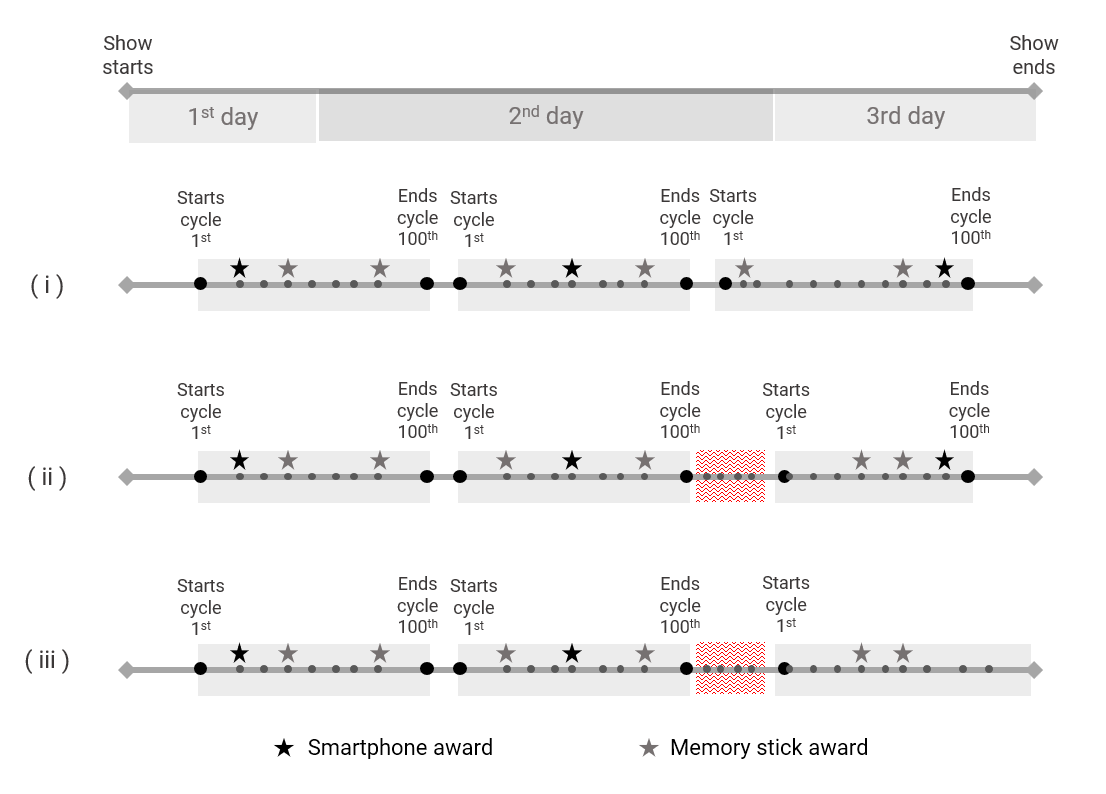
From the figure, it can be seen that the three days that the campaign will run for have been added.
For case (i), we can see that the cycle that begins on the first day does not reach the 100 participations to complete the cycle, so it spills over to the second day, where it completes. On the second day, there are three active cycles: the one that spilled over from the 1st day, a cycle that started and completed on that same day, and a third cycle that spills over to the next day, where it completes. This situation occurs when Reset count daily is left unchecked, making the time duration of the campaign only relevant to end it, but it does not intervene in the award of prizes.
Case (ii) shows the impact of checking the Reset count daily box: prevents a new award cycle from starting if that day contains a whole completed cycle, that is, the cycle started and ended on the same day. The cycle that started on the 1st day that did not complete will continue to be active until it reaches the 100th participation on the second day. A new cycle begins immediately after the first cycle ends, with a new participation, and it ends before the day is over. The red shaded area includes participations that were done after the 2nd cycle ended, and these participations will not be awarded a prize. After the 2nd day ends, the first participation on the third day will initiate a new cycle in which prizes can be awarded.
Case (iii) is the same as (ii) except that it shows the possibility that not all prizes will be awarded because the participation where insufficient to complete the cycle, and the random nature of the awards.
NOTE ON MULTIPLE AWARDS TO A SINGLE PARTICIPANTIf you selected the "Endpoint" option or the "Subscription Form" as the Delivery Method, the same participant could win more than one prize. You can limit it to one prize by checking the "One Price p/ Participant" box.
Random Select
In Random Select, prizes are awarded based on a fixed number of predefined participants. The award is controlled through the number in the For everyts, r participants, randomly award one prize from the pool section. For example, if the number is set to 500, prizes will be awarded at the 500th participation. After that, the counter will be reset back to zero and begin counting participation until it reaches 500 again, at which point a new prize is awarded.
Prizes
The Prizes section is where campaign prizes are entered.

Selecting Add New Prize will present you with a pop-up form with the items that need to be specified to complete the definition of a prize.
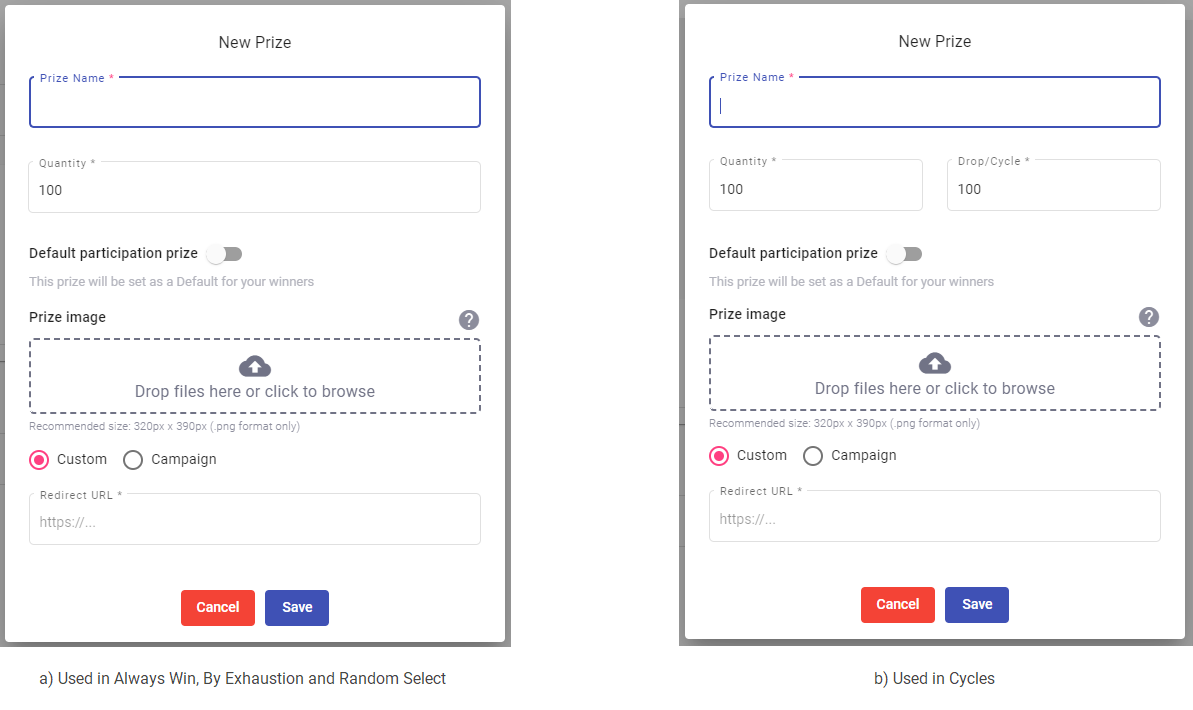
The steps to configure each prize are the following:
-
Prize Name : It is the information that will appear in the Name column of the table, with up to 30 characters in length, and it is mandatory as it is used for identification purposes in campaign reports.
-
Quantity : with a default value of 100, which is one of the options along with Default participation prize to establish the number of prizes.
-
Prize image: Upload the image of the prize. It will be presented to the participant if this prize is awarded to them if they win.
-
Select the redirect option either Custom or Campaign.
The Custom redirect is a user-defined URL that has been set up specifically for handling the prize being awarded. This way, each prize could have its URL to provide a unique experience for each campaign prize. Defining the Custom redirect consists of entering the URL in the entry box provided.

Selecting the Campaign radio button, a dropdown menu replaces the URL entry box.

Selecting the menu, the platform offers all the digital coupon campaigns that are available to be used as a prize for the campaign that is being configured.
With this knowledge, prize configurations can be completed for Always Win, By Exhaustion, and Random select.
All Prize Logics allow you to set up multiple prizes for a campaign, and each time a prize is added, it will show up in the table in the order in which it was entered, from top to bottom, with all its attributes:

In the Actions column, you can select to edit the configuration of the table entry through the Prize popup window or delete it.
Controlling prizes per participant
Further to what was described above, other conditions control the number of prizes that a participant can win. One of them is the way a campaign is made available to the targeted audience. Broadly, they can be classified as:
- Closed participation campaigns, or
- Open participation campaigns.
Closed participation campaigns
These are campaigns whose recipients are under the control of the platform, that is, they have been set up using one of the following options:
- Subscribers in the platform
- Uploading a CSV file
- Entered manually
These campaigns have established the number of potential participants, and the invitations to participate are explicitly sent to them, unique and not transferable. In all of these cases, the participant has only one chance to win a prize. Once a participation takes place, with its ensuing result, no further participations are allowed independently of the number of attempts that a user engages in the campaign. So, if the participation resulted in a win, the only possible action after that is to claim the prize. If it resulted in a loss, the platform offers the option to redirect them through a link to the following action.
Open participation campaigns
These are campaigns whose recipients are outside of the control of the platform, that is, they are participating in the campaign using one of the following options:
a. SMS Keyword
b. API Endpoint
c. The campaign involves scanning a QR code or entering/selecting a general URL link.
For these cases, the platform does not know the number of participants involved, because there is no explicit invitation, and anyone can participate multiple times with the exception of the API Endpoint case, where the participants are controlled outside of the platform and where multiple participations could be possible. For this case, you can restrict the participants to win only once by selecting the One Prize per p/Participant box.
Prize threshold notifications and replenishment
Given that for some campaign situations there might be a need to replenish the prizes being awarded in it, the platform has a built-in notification system that sends out an email to all active admin or operator members under the Users tab in the platform Preferences section.
As campaigns participations progress with time, and prizes are awarded, the Digital Customer Engagement platform keeps track of the number of each prize that has been included in the campaign, individually. This is, for each prize, the platform will monitor the remaining prizes left, and it has two thresholds that trigger the generation of email notifications regarding the quantities of prizes left. This will keep you updated on the status of the award process and give you the option to add more prizes.
The first email notification occurs at the threshold of when there are left 15% of the total prizes that were defined for that prize.
For example, a campaign has the following configuration: Prize 1, with quantity 100 prizes, Prize 2, with quantity 200, and Prize 3, with quantity 300. The platform will then generate an email notification when Prize 1 has 15 prizes left (15% of 100), another email notification when Prize 2 has 30 prizes left (15% of 200), and yet another notification when Prize 3 has 45 prizes (15% of 300) remaining to give away. In other words, the prizes are treated independently of one another, and consequently, the notifications are on a per-prize basis. A sample email for a 15% threshold is shown in the following screenshot.
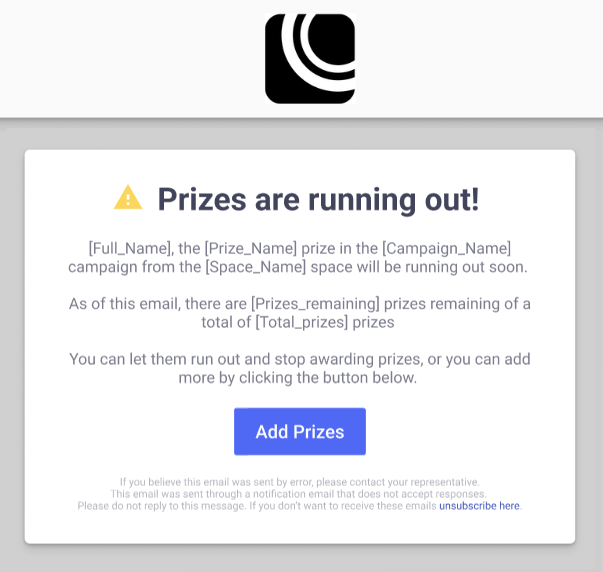
The second email notification occurs for any given individual prize when there are no more prizes to be awarded. When any prize is depleted, it will generate an email notification for that prize, informing of this condition. A sample email for this is shown in the following screenshot.
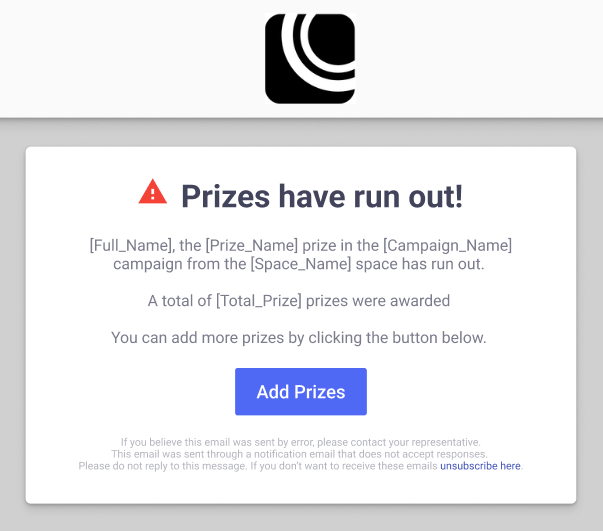
In each notification, you are given the option to add prizes to the campaign, provided that you are currently in the platform space from which the campaign is running.
The sample notification screenshots above show all the placeholders for the variable components of the notifications, pointing out:
- The addressee,
- The prize name,
- The campaign's name,
- The Space name,
- The total prizes awarded, and
- For the 15% threshold case, the remaining prizes of the total.
A sample notification email with all the fields populated would look as shown below.
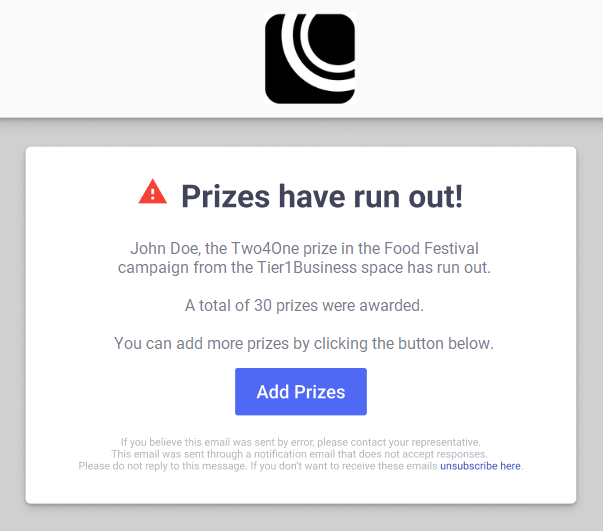
NOTIFICATION AUDIENCEEmail notifications will be issued to all platform users with operator or admin privileges, and the notification email allows each recipient to opt-out from receiving the notifications through the unsubscribe here in the footer.
Replenishing prizes to a campaign
If prizes are to be replenished, it can be done by ensuring that a session is opened in the Space in which the campaign was created, and selecting the Add Prizes button in the email. You will be taken to the campaign’s report section.
To add more prizes,
- Pause the campaign, through the icon at the far right.

- Select the edit icon, to open the campaign configuration.

- Proceed to the Prizes section.

-
Select the edit icon of the prize you need to replenish. Two samples of this scenario are shown in the following screenshot, where it shows the cases of 15% threshold and no prizes left.
-
Enter the number of prizes you are adding to the campaign. In the Remaining entry box is where you would enter the number of prizes to be added to the campaign.
-
Select Save.
-
Advance to the Summary step to relaunch the campaign.
The campaign will return to the Live state.
Updated 3 months ago

